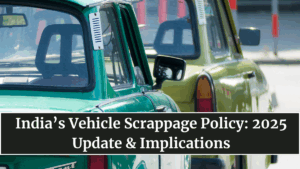India’s roads are evolving — and so are the rules that govern what drives on them. The Vehicle Scrappage Policy 2025 marks a major milestone in the country’s mission to modernize its automotive ecosystem. Designed to phase out old, polluting vehicles and replace them with cleaner alternatives, the updated framework combines environmental goals with economic opportunity.
With over 1 crore vehicles older than 15 years still running on Indian roads, this policy aims to reshape the auto market, boost recycling industries, and support the transition toward greener mobility.

What’s New in the 2025 Scrappage Policy Update
The updated scrappage policy refines earlier guidelines introduced in 2021, focusing on mandatory fitness testing, financial incentives, and digital transparency.
Key updates include:
-
Compulsory fitness tests: All private vehicles above 15 years and commercial vehicles above 10 years must pass an automated fitness test at registered centers.
-
Centralized digital records: Fitness results and scrappage certificates will now be linked directly with VAHAN and PARIVAHAN databases.
-
Extended incentives: Owners scrapping old vehicles receive up to ₹60,000 in benefits, including tax rebates and discounts on new vehicle purchases.
-
Green tax revision: Stricter green tax rates on older vehicles to discourage continued use.
-
OEM participation: Vehicle manufacturers must offer standard discounts (up to 5%) on new purchases against valid scrappage certificates.
This new version emphasizes a structured recycling economy, reducing environmental impact while creating thousands of new jobs in vehicle dismantling and steel recovery.
Economic and Environmental Benefits
The 2025 scrappage initiative is not just an environmental regulation — it’s a powerful economic catalyst.
Economic Impact:
-
Boosts new vehicle sales by replacing obsolete fleet stock.
-
Revives demand across steel, aluminum, rubber, and plastic recycling sectors.
-
Encourages investment in authorized scrappage centers across India.
-
Reduces import dependence for raw materials through metal recovery.
Environmental Impact:
-
Helps cut vehicular emissions by 25–30% in major cities.
-
Promotes cleaner air and lower carbon footprint.
-
Reduces fuel consumption by encouraging fuel-efficient models.
-
Decreases unregulated waste disposal from illegal scrapyards.
This policy creates a circular economy, where every end-of-life vehicle contributes to new manufacturing and infrastructure development.
The Roadmap for Implementation
The government has outlined a clear timeline for expanding the policy nationwide.
| Phase | Timeline | Key Focus |
|---|---|---|
| Phase 1 (2025) | January – December 2025 | Establish 150+ registered scrappage centers in Tier-1 and Tier-2 cities |
| Phase 2 (2026–27) | Include state transport fleets, municipal vehicles, and public buses | |
| Phase 3 (2028–30) | Full-scale enforcement across private and commercial vehicles |
Incentives will be combined with stricter penalties for non-compliance — including registration cancellations for vehicles that fail repeated fitness tests.
How the Scrappage Ecosystem Works
The process of scrapping is now fully digitalized and traceable:
-
Vehicle Assessment: Fitness testing determines if the vehicle is roadworthy.
-
Owner Authorization: Vehicle owners can register for scrappage via the VAHAN portal.
-
Scrappage Center Allocation: Authorized centers conduct eco-friendly dismantling using modern tools.
-
Recycling & Certificate Issuance: After dismantling, a Scrappage Certificate is issued, redeemable for benefits on new vehicles.
This transparent system ensures safety, accountability, and minimal environmental damage during the disposal process.
Impact on Used-Car and Fleet Markets
The new rules will have a ripple effect across India’s vehicle ecosystem:
-
Used-car dealers may see a temporary dip in older inventory demand, as fitness regulations tighten.
-
Fleet operators (especially logistics and cab companies) are likely to modernize faster to avoid penalties.
-
Automakers are expected to witness a surge in sales of entry-level models and small commercial vehicles.
-
Insurance providers will re-evaluate premiums based on vehicle age and compliance.
Ultimately, the scrappage drive will accelerate India’s shift toward electric and hybrid vehicles, opening room for innovation and localized manufacturing.
Challenges in Implementation
Despite strong intent, certain challenges remain:
-
Infrastructure gap: Many states still lack certified scrappage centers.
-
Owner awareness: Vehicle owners in rural regions may resist voluntary scrapping.
-
Cost of compliance: Fitness tests and transportation add extra expenses for older vehicle owners.
-
Informal sector control: A large portion of vehicle dismantling still occurs in unregulated markets.
To address this, the government is introducing financial aid for startups establishing eco-friendly recycling units and setting uniform testing fees nationwide.
The Future of Sustainable Mobility in India
By 2030, India’s scrappage policy is expected to remove over 50 lakh unfit vehicles from circulation, generating ₹10,000 crore worth of recycled materials annually. Combined with the EV and green fuel initiatives, this policy forms the foundation of India’s long-term clean mobility ecosystem.
The future Indian roads will be quieter, cleaner, and safer — powered by innovation, not pollution.
FAQs
What is the vehicle scrappage age limit in India?
Private vehicles older than 15 years and commercial vehicles older than 10 years must undergo mandatory fitness testing.
How can I scrap my vehicle officially?
You can register for scrappage through the VAHAN portal and choose an authorized recycling center for eco-friendly dismantling.
What benefits do vehicle owners get for scrapping old vehicles?
Owners can get road tax rebates, OEM discounts (up to 5%), and waiver of registration fees for new vehicles.
Is scrapping mandatory in 2025?
Yes, vehicles failing fitness tests or declared unfit under the new rules must be scrapped compulsorily.
What’s the environmental impact of this policy?
It helps reduce pollution, promotes recycling, and encourages cleaner, more efficient vehicles across India’s roads.
Click here to know more.
